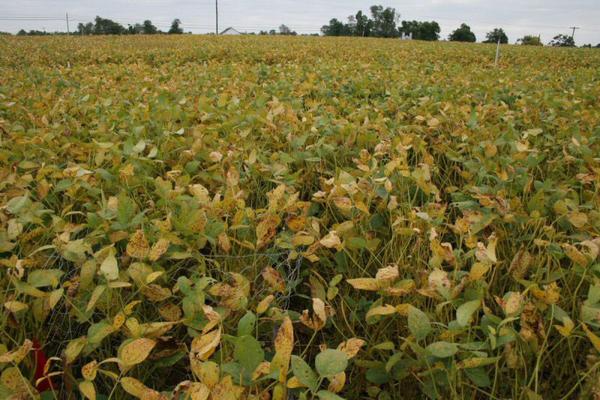Introduction
Asian soybean rust, caused by the fungus Phakopsora pachyrhizi, is a soybean pathogen described for the first time in the Southern portion of North Carolina in 2005. Rust is uncommonly observed during critical growth stages in North Carolina, and disease monitoring is conducted annually across the country via the Soybean Rust ipmPipe. Heavily infected plants may produce fewer pods, fewer seeds per pod, and reduction in weight resulting in yield losses.
Pathogen
The causal agent is the basidiomycete fungus, Phakopsora pachyrhizi. The soybean rust pathogen is an obligate biotroph, meaning that it must have a living host to survive. The alternate host to soybean rust is kudzu, which can be found abundantly in the Southern United States. The urediniospores are produced in pustules on the soybean host and may be windborne to other susceptible soybeans. At the end of the growing season, teliospores are formed as an overwintering spore. Although it does not overwinter in North Carolina, the rust pathogen survives in more Southern states and moves north each year as urediniospores when conditions are conducive.
Host Range
Soybean and several other legume species (peas, lima beans, alfalfa) are described as a susceptible to Phakopsora pachyrhizi. The alternate host to this rust is kudzu.
Symptoms
A common symptom of soybean rust is the formation of gray-green, tan to dark-brown, or reddish-brown lesions that may become erumpant under the lesions on leaflets. Lesions tend to be angular with 2-5 mm diameter, and can affect not only leaves, but may be observed on petioles, pods, and stems (Figure 1).
Lesions are associated with leaf chlorosis; high lesion density can cause defoliation and early maturity of the plant (Figure 2).
Disease Cycle and Conditions Favorable for Disease
Soybean plants are susceptible to rust at any growth stage. Rust epidemics are most severe during long periods of rain and temperatures between 60-82°F (16-28℃). While spores cannot overwinter under freezing weather conditions, spores can move rapidly across large areas. Spores are released from pustules and move through wind to a susceptible host. Once on a host, urediniospore germination and penetration requires 6-12 hours of leaf wetness and temperatures between 35-82°F (2-28℃). Lesions can produce spores within 7 to 14 days, which are then released and spread by wind. Large weather events, such as hurricanes, may also impact the speed at which disease epidemics move into North Carolina from other areas that have reported rust.
Management
The primary management of rust is through the use of fungicide applications. Fungicide applications made between R3 and R5 may provide the most yield protection for soybeans. Several fungicides are effective at reducing damages caused by rust, and efficacy can be found on the NC State Soybean Extension portal. Fungicide resistance is a concern with foliar pathogens, and different modes of action should be used if more than one fungicide is needed in a growing season.
Fungicides are likely not needed if soybean rust is not within 100 miles of a field. The Soybean Rust ipmPipe provides the locations of positive detections of soybean rust across the United States. Regularly scouting fields throughout the growing season is also important to monitor for foliar diseases like rust.
Useful Resources
- The American Phytopathological Society disease lesson page for soybean rust has more information about the biology and epidemiology of soybean rust in the United States
- The NC State University Plant Disease and Insect Clinic provides diagnostics and control recommendations
- The Extension Plant Pathology portal provides information on crop disease management
- The North Carolina Agricultural Chemicals Manual provides pesticide information for common diseases of North Carolina. The manual recommendations do not replace those described on the pesticide label, and the label must be followed.
Acknowledgements
This factsheet was prepared by the NC State University Field Crops and Tobacco Pathology Lab in 2020.
- Check out our Facebook and our Twitter!
Publication date: Sept. 2, 2020
N.C. Cooperative Extension prohibits discrimination and harassment regardless of age, color, disability, family and marital status, gender identity, national origin, political beliefs, race, religion, sex (including pregnancy), sexual orientation and veteran status.
NC Cooperative Extension prohíbe la discriminación por raza, color, nacionalidad, edad, sexo (incluyendo el embarazo), discapacidad, religión, orientación sexual, identidad de género, información genética, afiliación política, y estatus de veteran.
The use of brand names in this publication does not imply endorsement by NC State University or N.C. A&T State University of the products or services named nor discrimination against similar products or services not mentioned.
Recommendations for the use of agricultural chemicals are included in this publication as a convenience to the reader. The use of brand names and any mention or listing of commercial products or services in this publication does not imply endorsement by NC State University or N.C. A&T State University nor discrimination against similar products or services not mentioned. Individuals who use agricultural chemicals are responsible for ensuring that the intended use complies with current regulations and conforms to the product label. Be sure to obtain current information about usage regulations and examine a current product label before applying any chemical. For assistance, contact your local N.C. Cooperative Extension county center.
N.C. Cooperative Extension prohibits discrimination and harassment regardless of age, color, disability, family and marital status, gender identity, national origin, political beliefs, race, religion, sex (including pregnancy), sexual orientation and veteran status.


